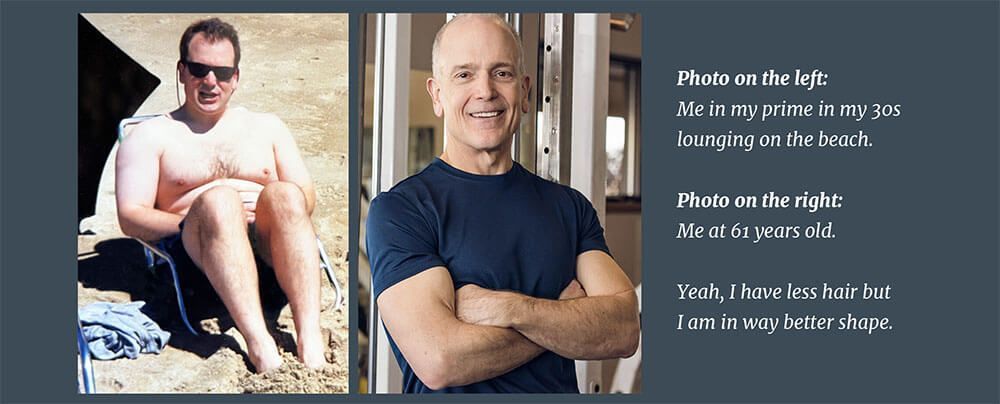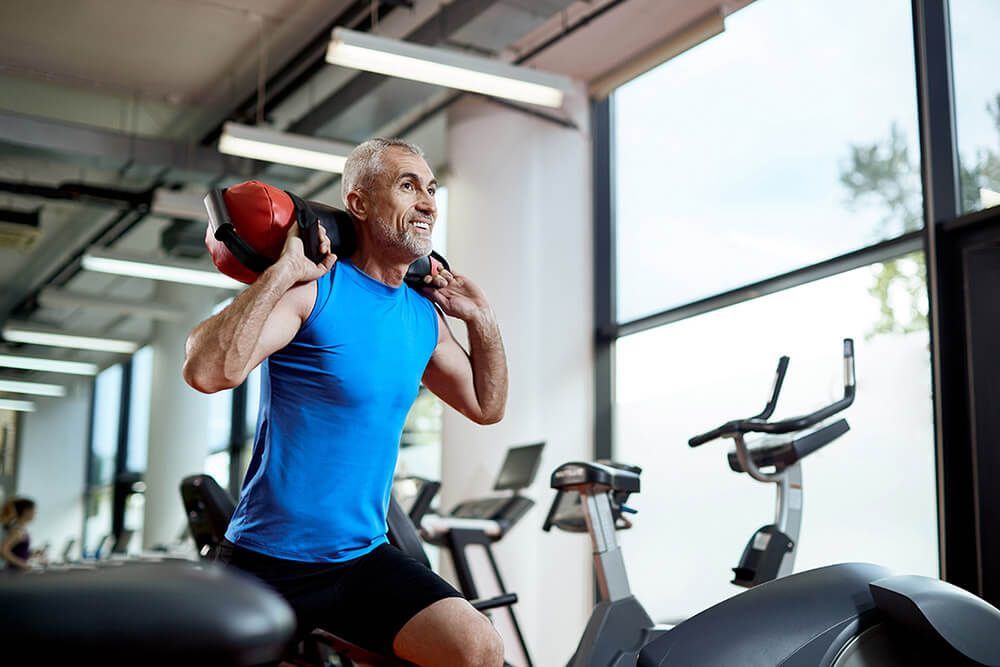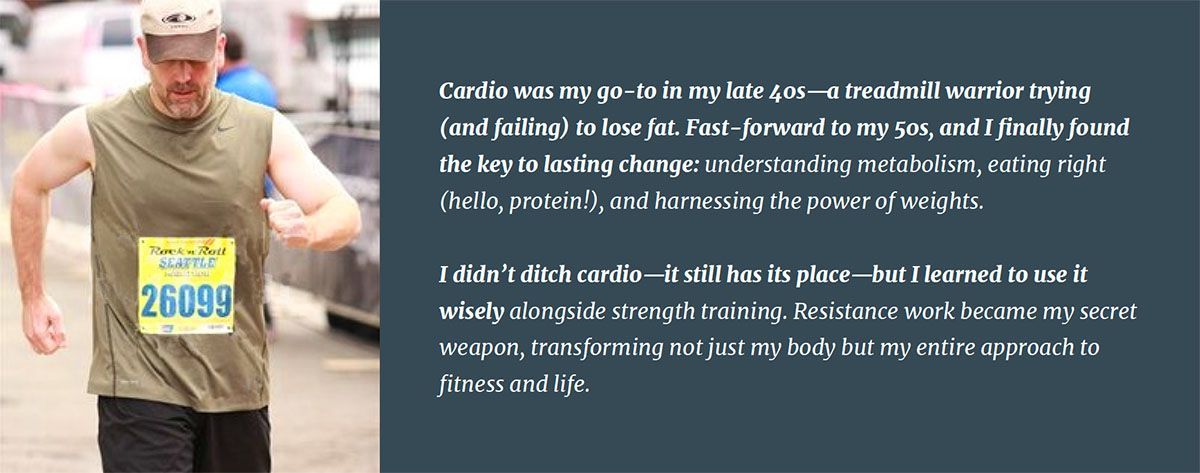Want to Get Fit, Strong, and Lean After 50?
Learn about my journey from a cardio-heavy routine in my 40s to a transformative switch in my 50s, emphasizing resistance training, nutrition, and smart cardio. Learn five steps to revive metabolism, build muscle, lose fat, and sustain health after 50. Get your free eBook! No email required.
Your 5 Essential Steps to Revive Your Metabolism, Build Muscle, and Lose Fat
Learn about the following and get your free eBook below.
- Restart your metabolism without starvation diets
- Build muscle and burn fat with simple, at-home steps
- Discover why walking and strength training beat cardio every time
Get your free eBook below. No email required!
In my 40s, I was all about cardio.
Not because I was trying to break any records. I was just a regular guy, stuck in an on-again, off-again battle with my waistline.
My strategy? As a marketing consultant, I spent hours sitting at my desk, so when it came to fitness, I tried to counteract that with hours on the treadmill and pounding the pavement, hoping it would do the trick.
Sure, I lost some weight, but it always crept back. Worse, I was plagued by persistent lower back pain that sabotaged my efforts and halted any real progress.
Looking back now, it’s so clear where I went wrong. I thought cardio was the magic bullet. I wasn’t paying attention to my diet, especially how much protein I ate. I was fixated on burning calories and logging miles, but my progress always stalled out.
Here’s the harsh truth:
- I wasn’t fueling my body with the right foods.
- I was sitting far too much—life as an online marketing consultant will do that to you.
- I relied on cardio as a fat-fighting weapon.
- I dabbled in resistance training, but it never stuck.
The result? I was stuck in a frustrating cycle of pain, mediocre results, and stagnation.
I didn’t look how I wanted to look, I didn’t feel good, and I was spinning my wheels, unsure how to fix it.
This doesn’t even mention how bad I was in my mid-thirties. At around 240 pounds, I was far from healthy. I carried extra weight that drained my energy, made every movement feel harder, and left me uncomfortable in my own skin. I wasn’t just out of shape—I felt like crap and was heading toward serious health risks.

Seeing that photo now is a big fat reminder of how far I’ve come and how much I needed to change.
Things finally changed in my 50s. I began to understand the key elements I’ll share with you in this post: how metabolism works, why the right foods matter (especially protein), and the incredible transformative power of resistance training. This isn’t about giving up cardio—it’s about using it wisely together with strength work.
Want to Get Fit, Strong, and Lean After 50?
Learn about my journey from a cardio-heavy routine in my 40s to a transformative switch in my 50s, emphasizing resistance training, nutrition, and smart cardio. Learn five steps to revive metabolism, build muscle, lose fat, and sustain health after 50. Get your free eBook! No email required.
Where are you on your journey?
Maybe you’ve been in my shoes, chasing the wrong goals with the wrong methods. Or, perhaps you’ve been avoiding fitness because it feels overwhelming. The good news? It doesn’t have to be.
As you age, reshaping your body isn’t about working harder—it’s about working smarter. Whether you want to drop stubborn belly fat, build muscle, or reclaim energy, the key isn’t to starve yourself or grind through endless cardio.
It’s about nourishing your body, optimizing your metabolism, and building strength.
I will show you how to do exactly that: lose fat, gain muscle, and create a sustainable lifestyle where you move better, feel better, and live better.
Let’s get started.
1. Understanding Your Metabolism After 50
Here’s the deal: your metabolism is adaptive. Think of it as your body’s thermostat, adjusting based on how you fuel your body and move.
In your 20s and 30s, you could bounce back from bad eating habits or crash diets. After 50, not so much. Hormonal shifts, like declines in testosterone and growth hormone, combined with muscle loss (sarcopenia), mean your body burns fewer calories.
The result? Losing fat feels harder, and keeping it off feels impossible.
Why does this happen? Metabolic adaptation—the body's survival mechanism to ensure it has enough energy to perform essential functions.
When you eat less or burn more calories through activity, your body adjusts by burning fewer calories. This can slow or stall fat loss and isn’t exclusive to aging; it can affect people in their 20s, 30s, and 40s.
But here’s the thing: it becomes way more pronounced as you reach your 50s, 60s, and 70s due to hormonal changes, reduced muscle mass, and shifts in overall activity levels.
Research from the University of Alabama at Birmingham illuminates this challenge. Their study, "Weight loss may take longer than expected due to metabolic adaptation," shows how this process can make shedding stubborn belly fat super frustrating. Been there, so done that!
This adaptation feels like hitting an invisible wall—a soul-crushing, but entirely natural response to energy intake and expenditure changes.
Are you over 50 and want to get fit? Strength training isn’t optional—it’s essential. It’s the foundation for staying strong, sharp, and independent as you age. Don’t wait around; waiting is how you lose your edge. Start today, audit your routine, and make strength a non-negotiable part of your life. Act now, and keep showing up—day after day.
The Solution: Rebuilding Your Metabolic Machinery
It’s not all bad news!
You can fight "aging metabolism" with a killer strategy–Rebuilding the metabolic machinery you’ve lost over the years – muscle.
Muscle isn’t just for strength—it’s a metabolic powerhouse. The more muscle you have, the more efficiently your body burns calories, even at rest. Strength training teaches your body to use energy more effectively, helping you maintain a leaner, stronger physique as you age.
- Resting Metabolic Rate (RMR): The calories you burn at rest for basic functions like breathing and digestion.
- Basal Metabolic Rate (BMR): The energy your body needs to stay alive—just breathing, pumping blood, and keeping your brain working.
Strength training and a high-protein diet help prevent muscle loss and can boost your RMR by building lean muscle, which in turn supports your BMR. Together, these determine how many calories you burn each day—and building muscle is your secret weapon to keeping your metabolism running efficiently.
What About Hormones?
I mentioned hormones, so you might be wondering about their role in this. It's a hot topic in fitness circles, and for good reason. While we won't dive too deep into the science, here's what you need to know:
Hormones, especially insulin, play a crucial role in how your body manages fat and builds muscle.
Think of your muscles as sponges for glucose (sugar) in your blood. When you lift weights, you're making those sponges bigger and more efficient at soaking up glucose.
Here’s why that matters:
Resistance training improves insulin sensitivity, meaning your body regulates blood sugar more effectively. Instead of experiencing blood sugar spikes and fat storage, your muscles become better at using and storing glucose for sustained energy. This helps stabilize energy levels and supports long-term metabolic health.
Strength training enhances androgen receptor activity, making your body more responsive to testosterone. Since testosterone naturally declines with age, improving its effectiveness helps maintain muscle mass, energy levels, and overall vitality—key factors for staying strong and fit in your 40s, 50s, and beyond.
Resistance training also supports healthy growth hormone and cortisol levels, both essential for recovery, fat metabolism, and reducing inflammation. By keeping these hormones balanced, you improve stress management, fat loss, and muscle recovery.
While the relationship between muscle and metabolism is complex, here’s the key takeaway: Regular resistance training doesn’t just build strength—it transforms how your body processes energy, helping you burn fat, stabilize hormones, and optimize overall health.
The Big Picture: A Stronger, Healthier You
Remember, building muscle through resistance training isn't just about getting stronger – it's about creating a more efficient, healthier body from the inside out.
It’s also about optimizing your hormones and metabolic health, so your body stays in peak condition as you age.
But here's the key: while hormones matter, they're just one piece of the puzzle. The most effective approach combines understanding how your body works with practical, everyday habits.
Focus on eating whole foods consistently, getting regular exercise (especially strength training), and discovering what works best for your body.
You want to create a lifestyle that keeps you healthy and strong for the long haul. That’s what this book is all about—losing fat, gaining muscle, and looking, moving, and feeling better for the long term!

2. Why Cardio Alone Won’t Make You Lean
But Strength Training, Protein, and Smart Nutrition Will
In my 40s I was deep into cardio—not because I was chasing a personal record, but because I thought it was my ticket to weight loss.
As a marketing consultant spending long hours at a desk, I tried to counteract my sedentary lifestyle with endless treadmill or road runs.
The result? Some weight loss here and there, but it always crept back. Worse, I struggled with persistent lower back pain, which derailed my progress.
Looking back, it’s clear where I went wrong.
- I wasn’t fueling my body properly, and my diet lacked high-quality protein.
- I also thought cardio alone was the magic solution.
I’d log miles, burn calories, and wait for results that never came.
Sound familiar? It’s a common trap, and here’s why it doesn’t work.
Why Cardio Alone Can Backfire
Many people think cardio is the magic bullet for fat loss, but over-relying on it might backfire.
If all you do is long cardio sessions—without strength training or the right nutrition—you could be making fat loss harder, not easier.
Here’s why. Over time, your body adapts by becoming more efficient at conserving energy, meaning you burn fewer calories.
This is known as metabolic adaptation, and while it’s great for survival, it’s not ideal for fat loss.
Without enough protein or resistance training, your body may break down muscle for energy when you're in a calorie deficit.
Losing muscle lowers your basal metabolic rate (BMR)—the number of calories your body burns at rest—making it even tougher to lose fat and keep it off.
Cardio isn’t the enemy—it’s great for heart health and endurance, but it works best when combined with strength training and a nutrient-packed diet. Trust me, it took me forever to figure this out, but once I did, everything changed.
Metabolic adaptation happens at any age but becomes more pronounced in your 50s and beyond due to muscle loss and hormonal shifts.
Cardio is important, but it’s just one piece of the puzzle. Strength training and proper nutrition—especially enough protein—are a must.
The old “eat less, move more” mantra might backfire, leading to frustration and plateaus.
To lose fat, get stronger, and stay healthy long-term, you need to fuel your body wisely. Eating enough nutrient-dense foods helps preserve muscle, support metabolism, and keep you strong and energized.
It’s not about eating less; it’s about eating smart and training the right way—combining strength work, cardio, and proper nutrition to keep your body strong, energized, and resilient.
Want to Get Fit, Strong, and Lean After 50?
Learn about my journey from a cardio-heavy routine in my 40s to a transformative switch in my 50s, emphasizing resistance training, nutrition, and smart cardio. Learn five steps to revive metabolism, build muscle, lose fat, and sustain health after 50. Get your free eBook! No email required.
Protein: The Cornerstone of Fat Loss
Here’s where things really clicked for me. Once I prioritized high-quality protein in my diet, everything changed.
Protein isn’t just for bodybuilders; it’s essential for everyone, especially if you want to lose fat and gain muscle.
If you’re over 50 and want to lose fat and gain muscle, it’s a must.
Aim for 1 gram of protein per pound of your target body weight—if your goal is 185 pounds, aim for 185 grams daily. You can go slightly lower, around 0.8 grams per pound, but 1 gram is a solid target to support muscle repair and growth. Prioritize high-quality protein sources for better results.
Why Does Protein Matter So Much After 50?
- Muscle Maintenance and Growth: Protein provides the building blocks your muscles need to repair and grow, which keeps your metabolism running efficiently.
- Satiety: It keeps you full, reducing cravings and making it easier to stick to your plan.
- Thermogenic Effect: Thermo-what? It’s a fancy way of saying your body burns more calories digesting protein than fats or carbs—a win for fat loss.
Pro tip: Focus on whole, nutrient-dense sources like lean meats, fish, eggs, Greek yogurt, and legumes. Whole foods are naturally satisfying and trust me, it’s tough to overeat grilled chicken or plain Greek yogurt.
Eat to Fuel, Not Deprive
Food isn’t the enemy—it’s fuel. The right nutrition powers your muscles, supports healthy aging, and keeps you feeling your best.
After 50, diet isn’t just important—it’s essential. Pair nutrient-dense meals with strength training; you’ll build muscle, lose fat, and boost energy.
This isn’t about eating less; it’s about eating smart. Fuel your body, fire up your metabolism, and reclaim your energy.
I wish I’d learned this sooner, but trust me—it works.
Everyone’s different, so find what works for you.
Eat well, train smart, and let your metabolism do the work.
Cardio was my go-to in my late 40s—a treadmill warrior trying (and failing) to lose fat. Fast-forward to my 50s, and I finally found the key to lasting change: understanding metabolism, eating right (hello, protein!), and harnessing the power of weights.
I didn’t ditch cardio—it still has its place—but I learned to use it wisely alongside strength training. Resistance work became my secret weapon, transforming not just my body but my entire approach to fitness and life.
3. The Exercise Prescription: Build Muscle, Burn Fat
Lift, Rest, Repeat
Hours of cardio used to leave me feeling drained and frustrated.
That’s why I started lifting—it’s an amazing way to build muscle, burn fat, and just feel better.
It can do the same for you!
I lift four times a week, but here’s the good news: you only need two sessions a week to start seeing results.
On your off days, mix in activities you love, like biking, light runs (1.5–2 miles), or just walking (more on that later!)
You might also try something new like rucking (walking with a weighted backpack).
Just make sure you keep it simple and fun so you’ll continue the habit!
So Craig, why resistance training?
Because it’s your secret weapon against the natural aging process.
As we age, our bodies face challenges like sarcopenia (age-related muscle loss) and osteopenia (bone density loss).
Lifting fights both by building muscle and strengthening bones, but it doesn’t stop there.
Strength training doesn’t just build muscle—it boosts your mood, sharpens your focus, and might even help reduce the risk of Alzheimer’s.
According to research from the University of Sydney, lifting weights can slow brain degeneration and protect areas vulnerable to Alzheimer’s for up to a year after just six months of consistent training. You can read more about this study here.
So, when you lift that dumbbell, you’re not just building strength—you’re future-proofing your body and mind. It’s an investment in your health that pays off for years to come.
And there is a super-easy supplemental exercise we should all be doing…

4. Walking: Your Perfect Resistance Training Partner
That’s right. Walking might seem basic, but it’s one of the best ways to supplement resistance training.
Really? Yep!
Walking is low-risk, easy to sustain, and offers a net positive for almost anyone.
While it won’t build endurance like running, it’s fantastic for fat loss, recovery, and overall energy.
Plus, walking spares your muscle mass, unlike excessive cardio, which can eat away at those hard-earned gains.
Let’s be real: running has a high injury rate, and it can interfere with strength training benefits.
But walking burns calories, aids recovery, and doesn’t put much stress on your body. It’s the ultimate recuperative exercise. And it’s so easy to fit into your day.
- Walk 10 minutes after meals. Great for digestion and consistency.
- Park farther away. Turn errands into mini workouts.
- Take the stairs. Skip the elevator and get moving.
No equipment, no gym membership, no awkward biker shorts—just walk.
Walking complements and amplifies strength training!
Studies show that walking 7,000+ steps daily can reduce the risk of early death by 50-70%. Aim for 10,000 steps a day to improve cardiovascular health, build muscle tone, and support a strong metabolism. Read the study here.
Strength Is the Foundation
By now, you know my story—and why I believe in resistance training for people over 50 (like me!).
Cardio has its place, but strength training is the real game-changer. It builds muscle, burns fat, and keeps you strong for life.
Beyond fitness, it fuels your energy, supports longevity, and just makes you feel better. Whether you're in your 40s, 50s, or beyond, getting stronger is always an option. And trust me, it’s worth it.
For me, strength isn’t just part of the routine—it’s the foundation.
Want to Get Fit, Strong, and Lean After 50?
Learn about my journey from a cardio-heavy routine in my 40s to a transformative switch in my 50s, emphasizing resistance training, nutrition, and smart cardio. Learn five steps to revive metabolism, build muscle, lose fat, and sustain health after 50. Get your free eBook! No email required.

5. Why Strength Training Wins Over Cardio
Here’s the thing about cardio: it’s great while you’re doing it—it burns calories in the moment.
And don’t get me wrong, I still love cardio!
I do!
Thing is, I logged too many hours running and cycling back in the day, but I’ve shifted my focus these days.
Why?
Because I realized something that changed how I approach fitness.
Strength training, unlike cardio, keeps working for you long after you’re done lifting.
It’s like the gift that keeps on giving.
Muscle is your body’s metabolic powerhouse—it burns calories even when you’re kicked back on the couch watching Netflix, cheering for your team, or chilling with your favorite book.
Let’s call it the “Afterburn Effect.”
Do you ever notice your body still feels in overdrive hours after a good workout? That’s the “afterburn effect” in action.
Officially called excess post-exercise oxygen consumption (EPOC), it’s how your body resets after exercise.
Translation?
You’re burning calories even at rest because your metabolic state is elevated, burning more calories than it would at rest.
The more muscle you build, the more calories you burn around the clock.
Here’s another reason strength training is a winner: it’s incredibly effective at reshaping your body.
Resistance training isn’t just about gaining muscle—it improves your overall body composition and boosts insulin sensitivity better than cardio alone.
That means you’re not just getting leaner; you’re also improving how your body handles sugar, reducing your risk of chronic issues like diabetes.
Too much cardio can work against you. When you rely on endless running or cycling as your main workout, your body adapts by becoming more efficient at conserving energy.
While that might sound great, it often leads to burning both fat and muscle.
I found this out the hard way during my road-running and treadmill obsession. I was clocking more miles than ever and sticking to a pretty healthy diet, but I still couldn’t shake that stubborn body fat.
I wasn’t feeling stronger or fitter—I was just tired.
Losing muscle slows your metabolism, making it harder to keep the weight off in the long run.
Instead of helping you build a stronger, more capable body, excessive cardio can leave you stuck, frustrated, and further from your goals.
So, think of walking as the perfect complement to strength training. It’s low-impact, easy to incorporate daily, and enhances recovery while keeping you active without the risks of overdoing it.
Strength training lays the foundation for building muscle and boosting your metabolism; walking supports it by keeping you mobile, active, and engaged.
Together, they form a balanced approach to fat loss, muscle building, and staying strong for the long haul.
Cardio is great—just remember, moderation is key!
How to Get Started
I’ll be honest—I’ve been that guy. I spent hours on the treadmill, feeling like an overcaffeinated hamster on a wheel, running my heart out, chasing results that didn’t satisfy me.
In my late 40s, my fitness routine was all cardio—sweaty sessions that felt great in the moment but left me wiped out and no stronger.
Yeah, I got a little skinnier, but I didn’t have the muscle tone or strength I wanted. When I flipped the script in my 50s making strength training the priority, everything finally registered.
You?
Start simple and focus on the basics.
Quality beats quantity every time. Foundational moves like squats, deadlifts, presses, and rows work multiple muscles, giving you the biggest bang for your buck.
If you’re not ready for weights, no problem. Bodyweight exercises are a great starting point—they help you build balance, stability, and mobility while laying the groundwork for future strength.
The Bottom Line
Cardio has its place, but too much can burn muscle and slow recovery.
Walking however complements strength training, supports recovery, spares muscle, and boosts longevity, fat loss, and mental health.
So, ditch the hamster wheel.
Lift, walk, rest, repeat—and watch as your body transforms in ways you never thought possible.
My final bit of advice…
Keep It Simple and Get Started
You don’t need a complicated plan to start seeing results. Just two or three full-body strength sessions a week—30–45 minutes each—can make a world of difference.
Combine strength training with good nutrition (hello, protein!) and quality rest, and you’re on your way.
The key isn’t perfection—it’s consistency. Start small, find your rhythm, and build an unbreakable habit. Strength training, done consistently, will transform your body and mindset.
Lifting weights changed my life, and it can change yours too. It’s not about chasing extremes—it’s about creating a fitness routine that works for you.
With the right approach and a little sticktoitiveness, you’ll lose fat, gain muscle, and feel better.
And it all starts with the foundation: movement.
Next up?
A simple, effective active stretching routine to wake up your muscles and get you ready for strength training.
Ready to take the next step?
Join me here:
Your Dynamic 50+ Warm-up Guide and let’s get started!
Want to Get Fit, Strong, and Lean After 50?
Learn about my journey from a cardio-heavy routine in my 40s to a transformative switch in my 50s, emphasizing resistance training, nutrition, and smart cardio. Learn five steps to revive metabolism, build muscle, lose fat, and sustain health after 50. Get your free eBook! No email required.
Do You Want More Details About Our Fitness Coaching Services?
Let us know how we can help you reach your fitness goals!


